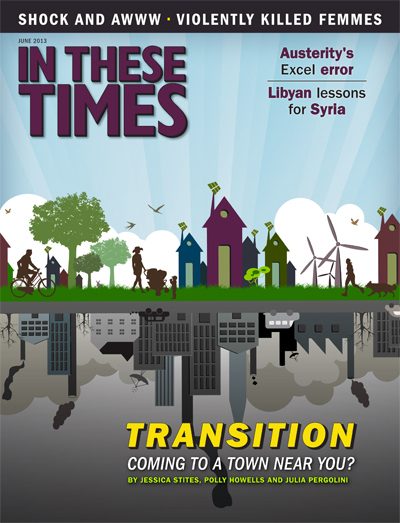Is Your Town in Transition?
Out of a quaint English town, a sustainability movement goes global.
Jessica Stites

When I set out to investigate the appeal of Transition, a sustainability movement that has spread to 1,105 towns in 43 countries over the past eight years, I started with what I thought was a basic question: What are “Transition Towns” transitioning to?
“Resilience,” I was told. “What does that mean?” I asked, thinking vaguely of steel. “The ability to absorb shocks to a system!” was the reply. Well, yes, but …? Pressed for details, Nina Winn, who runs a Transition initiative at the Institute of Cultural Affairs in Chicago, said, “I don’t think there’s a conclusion. Like when a person’s trying to self-improve, it’s a constant growth. Our communities would grow to be a lot more intimate. We wouldn’t be hesitant to ask for that cup of sugar or tomato. The streets would be narrower instead of expanding; there would be fresh produce on every corner that was grown just down the street. You would see people on the street because of that — because where there’s food, there’s people.”
Such bucolic but fuzzy visions are typical of Transition, which is more about shifting paradigms than prescribing solutions. With an it’ll-take-shape-as-we-go ethos, most Transition Town websites sport a “cheerful disclaimer”: “Just in case you were under the impression that Transition is a process defined by people who have all the answers, you need to be aware of a key fact. … Transition is a social experiment on a massive scale.”
On a basic level, however, the experiment seeks to address what founder Rob Hopkins sees as a source of frustration in the environmental movement: Personal action feels like a drop in the bucket, while governments often move at a glacial pace.
“Until now, there’s been the things you can do at home on your own — changing your lightbulbs and sharing your lofts and things — and then there’s everything else that someone else is meant to do: the sort of mythical ‘they,’” says Hopkins. “Transition is what’s in the middle, what you can do with the people on your street.”
The seed for Transition came in 2004 when Hopkins, a young teacher with a degree in environmental quality and resource management, encountered the concept of peak oil: the theory that easy-to-reach oil will run out at a specific date — some say 2020 — precipitating a rapid decline in oil availability followed by the collapse of civilization as we know it. At the time, Hopkins was teaching a permaculture course at the Kinsale College of Further Education, an alternative school on Ireland’s southern coast. Permaculture is another one of these concepts that, as Hopkins notes, is “notoriously difficult to explain in two minutes in the pub,” but it’s most commonly described as an ecological design movement that sees nature in terms of interlocking systems. Alarmed by peak oil, Hopkins assigned his students to apply the principles of permaculture to the problem.
The result was a concrete plan to make Kinsale dramatically less fossil-fuel dependent, with recommendations such as a green buildings officer and a horse-and-cart taxi. The Kinsale Town Council enthusiastically adopted the plan, and the principles underlying it became the precepts of Transition, as outlined in Hopkins’ 2008 Transition Handbook: From Oil Dependency to Local Resilience and as adopted by Transition Towns worldwide.
But it would be a mistake to think that becoming a Transition Town means setting off on a clear-cut path to energy independence. From permaculture, the movement has inherited a non-linear, bottom-up approach — even the original 12 “steps” outlined in Hopkins’ handbook have been renamed “ingredients.” If the Transition movement has a sine qua non, however, it is the belief that communities must become more resilient in the face of three catastrophic threats: peak oil, global warming and economic instability. Whether the movement means to avert or adapt to future disasters is ambiguous; when I ask, Transition members tend to respond, “Both!” as though I have just recited their favorite koan.
Practically, this means preparing towns to better survive sudden shortfalls of such necessities as food, oil, water or money. These preparations take many forms, some infrastructural — such as solar energy programs and local economic initiatives — others interpersonal, like the “heart and soul” groups that encourage people to help each other in times of need and open their minds to new solutions.
Totnes, England, declared the first official Transition Town in 2006, offers perhaps the most fully realized example. The town, with a population of 7,400, boasts nearly 30 Transition projects and sub-projects. Some are small-scale, like nut-tree planting and a free “bike doctor,” while others are more ambitious, like an incubator for sustainable businesses and a 305-page Energy Descent Action Plan to cut the town’s energy usage in half by 2030. The movement is enthusiastically backed by the city mayor and the town councilors, one of whom attests that “the [Energy Descent Action Plan] has filtered into everyone’s plans for everything, so that’s had a major impact.” A much-heralded neighborhood-level project has been Transition Streets, which brought residents together, block by block, to support each other in decreasing their home energy use through improvements like insulation and solar panels. On average, each of the 550 participating households cut its annual carbon use by 1.3 tons and its annual energy bill by £570 (about $883).
Hopkins stresses, however, that the Transition movement is not in the business of stamping out cookie-cutter copies of Totnes. Transition spreads primarily through serendipity. One member likens it to a mycelium network, a fungus with underground roots that can sprout new shoots miles away. In effect, this means that someone — often with a background in sustainability — stumbles across Transition online or in print and decides to start a local chapter.
While guidance is available from umbrella support groups such as Transition U.S. and the U.K.-based Transition Network, the movement is intended to mutate as it grows. “We designed it with a simple set of principles and tools and sort of set it off, and it keeps popping up in the most incredible, surprising places, in the most incredible, surprising ways,” says Hopkins. “When there’s Transition happening in Brazil, it feels like a Brazilian thing, it doesn’t feel like an English imported thing.”
Indeed, the organizers of Brazil’s Transition movement say that two of the three core principles — peak oil and climate change — don’t resonate strongly with the Brazilian public, so Transition trainings focus more on “assuring education and health for all, protecting biodiversity and enhancing autonomy of traditional (indigenous or not) local communities.” In Brasilândia, one of the slums of São Paulo, Transition primarily fosters social enterprise projects; it has given birth to a community bakery and a business turning old advertising banners into bags.
In parts of Europe, Transition has had to respond to the pressing needs of communities decimated by the ongoing Eurozone crisis. When the city of Coin, Spain, went bankrupt and decided to privatize the water, Coin En Transicion gathered 3,000 signatures to convince the city to squash the plan. Now the movement is working with the city government to design a regional water plan grounded in principles of sustainability and resilience.
In Portugal, where unemployment is at 16.9 percent and climbing, the Transition Town of Portalegre has drawn inspiration from ajujeda, an ancient rural practice of trading chores in the fields. This month, Portalegre em Transição will meet to figure out how to translate the principle of ajujeda into a functioning gift economy, allowing those whose skills are not being used (for instance, the unemployed) to share them with those whose needs are not being met.
Across the pond
In making the leap across the Atlantic to the United States, where more than 139 Transition Towns and 200 unofficial “mullers” have sprouted, Transition has also taken its own, distinct path.
Most of the Transition towns in the United States have popped up in places one might expect: relatively moneyed, green, hippie enclaves like Boulder, Colo. (the first official U.S. Transition Town); Sebastopol, Calif.; Northampton, Mass.; and Woodstock, N.Y. None have taken root so far in any conservative strongholds, although there are a number of urban initiatives, in Boston, Houston, Los Angeles and Cleveland, to name a few.
As in the United Kingdom, members of the U.S. Transition movement tend to split up into working groups around specific projects. A common one is an “emergency preparedness” group, which devises things like phone trees and alternative heating sources for use in the event of disaster. “Yard share” working groups match would-be gardeners to landowners willing to lend a patch of fertile ground. “Heart and soul” or “inner transition” working groups stress psychological and spiritual transformation, drawing on the teachings of thinkers such as Buddhist deep ecologist Joanna Macy. “Reskilling” working groups offer trainings in all manner of practical pre-industrial skills, from cheesemaking to animal husbandry to knot-tying to knitting.
Of course, Transition is not the only sustainability game in town. Wherever it goes, and especially in cities, it enters a terrain thick with environmental non-profits and local government initiatives. More than 1,060 mayors have signed the U.S. Conference of Mayors Climate Protection Agreement, a pledge to meet the goal of the Kyoto Protocol (the United States was one of only four countries not to join) to reduce carbon emissions below 1990 levels. Some cities have gone beyond that: Last year, Chicago drafted a sustainability plan for the year 2015 that reads something like Totnes’s Energy Descent Action Plan — a laundry list of goals such as improving citywide energy efficiency by 5 percent and decreasing water use by 2 percent (14 million gallons a day). To get there, the city has launched numerous projects, such as eco-friendly overhauls of city buses, a “rails-to-trails conversion” of a disused train line into a park (modeled on New York City’s High Line), and a Sustainable Backyards Program that urges residents to install compost bins and rainwater collectors.
Given this abundance of initiatives, many Transition movements, especially in cities, take on a networking role to connect existing sustainability projects. Transition Pittsburgh’s mission is to offer “resources — such as educators, movie screenings and licenses, and a library of shared knowledge — to various local initiatives, as well as a city-wide community and some of our own projects.” Chicago’s Transition chapter — called Accelerate 77 after the division of the city into 77 unofficial communities by social scientists at the University of Chicago — set out by creating a dense map of the more than 800 sustainability projects underway in Chicago, which are remarkably evenly spaced throughout the areas of poverty and wealth that stratify the city. It hosted a “Share Fair” in September for the various groups to connect with each other, followed by three neighborhood gatherings on Chicago’s South, West and North Sides to connect with residents.
I asked Ryan Wilson of the nonprofit Center for Neighborhood Technology (CNT), a sustainability “think-and-do tank” that participated in the Share Fair, whether he thinks Transition has anything to add to Chicago’s wealth of sustainability initiatives. “It was helpful to learn what other projects are out there — maybe more helpful for some of the smaller groups,” he says. “The Transition folks — I like the people. I like their energy.”
This jives with Hopkins’ thinking on Transition, which has progressed from seeing “resilience” as a strictly environmental process to a more social one: “We have all the technologies to [achieve sustainability],” he says, “but we don’t have the social technologies to make it happen.”
The art of hosting
Transition’s freewheeling structure, however, does mean that certain problems — or “challenges” — seem to crop up frequently. As with any volunteer-driven movement, members describe burnout and lack of accountability. After a stage of initial enthusiasm, projects can fall dormant. More successful Transition Towns often have paid staff. After observing that most initiatives “were struggling with an all-volunteer leadership team,” Transition Sarasota founder Don Hall decided to raise the money to pay himself as a full-time organizer, cobbling together his salary from “a mix of event and workshop fees, donations, local business sponsorships and grants.” In many cities, Transition has been adopted by non-profits that provide paid staff, like Chicago’s Institute of Cultural Affairs, a 50-yearold organization dedicated to sustainability and social change, and Jamaica Plain’s Institute for Policy Studies, the Boston branch of a progressive, multi-issue D.C. think tank.
The Transition movement also grapples with the challenges of non-hierarchical, collective leadership. When I contacted Transition Sebastopol, in California, a longstanding, apparently thriving Transition town with a busy events calendar, I was surprised to learn that all was not well. A dispute in September had put the central Working Group Council on hold, although several working groups — an elders salon, the “heart and soul” group — are chugging along independently. Former working group member Julia Bystrova ascribes the blow-up to a lack of conflict-resolution mechanisms. She hopes that a fresh team will take over and resuscitate the group.
Hopkins is quick to cop to these pitfalls, and Transition is good at tapping into existing knowledge bases to fix problems. Transition U.S. has partnered with an organization called The Art of Hosting to offer facilitation trainings and will begin hosting regional courses on “effective groups” starting in September. Transition U.K. offers Thrive workshops for the same purpose, and ecofeminist and spiritual activist Starhawk gave a workshop in Totnes last month about clear communication and constructive critique in collective decision-making.
Another common concern about Transition, levied from both within and without, is that it is a movement of “white hippies.” While the definition of “hippie” is open to debate, each of the half dozen Transition towns I surveyed in the U.S. indeed lamented a lack of diversity. In addition to being predominantly white, participants in several towns mentioned that their initiative was made up primarily of older women.
Us Latinos have adapted to economic crises in our countries and in the US for many years. And we have always prevailed! We are creative, resourceful and entrepreneurial. Currently in the US, MA and JP we are experiencing a crisis that challenges our capacity of adaptation. Work opportunities are scarce, rent keeps going up, it becomes more difficult to afford a healthy diet and take the T, the quality of education in our public schools diminishes. …We invite you to share how you are adapting to this crisis or how you have adapted to previous crises. Tell us your stories of adaptation. We could transform your effort into a neighborhood effort with great impact in JP.
“There’s a value to the farmers listening to each other, humanizing each other,” says Reidelbach. “Then they are much less likely to dis each others’ methods, modus operandi and motives. I think everybody’s got to get down off their high horses. That’s one of the things that Transition enables.”
Modest expectations, high spirits
Asked if he eventually envisions Transition scaling up and being adopted by regional or national governments, Hopkins assents cautiously, explaining that the goal would be for government to better enable local projects (for instance, by making laws more friendly to small-scale farming). He also hopes that Transition will hit a tipping point at which new solutions seem possible — where, for instance, local governments don’t feel that the only solution to economic hardship is to try to attract large corporations in a deregulatory race to the bottom.
Espinoza-Toro says that he chooses Transition over other forms of organizing because he is inspired by the movement’s tangibility. “What I find most fruitful and rewarding about my work here is that I’m dealing with folks face-to-face in order to tackle some of these issues,” he says.
Again and again, for Transitioners, it seems to come back to that social aspect. “Between you and me, I don’t know if we’re going to solve the world’s problems,” says Reidelbach. “[But] the underlying ethos is that the process needs to be fun enough to be worth doing anyway. I love that about it. There’s a bit of anarchy, which is wonderful. People who are attracted to it tend to be upbeat, optimistic, joyous people.
“I don’t see anything meaningful happening at the top, with governments and multinational corporations,” Reidelbach continues. “Whether or not we win, Transition is the only group offering a model where I can deal with fossil fuel depletion and climate change myself.”
Jessica Stites is Editor-at-large for In These Times.









